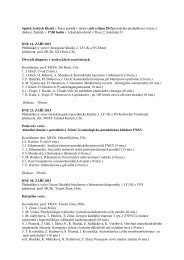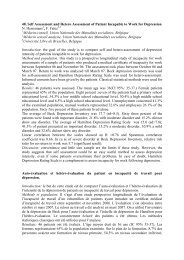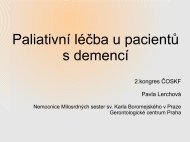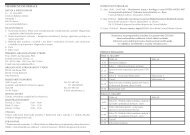ABSTRACTS â ORAL PRESENTATIONS - AMCA, spol. s r.o.
ABSTRACTS â ORAL PRESENTATIONS - AMCA, spol. s r.o.
ABSTRACTS â ORAL PRESENTATIONS - AMCA, spol. s r.o.
You also want an ePaper? Increase the reach of your titles
YUMPU automatically turns print PDFs into web optimized ePapers that Google loves.
cell lines using multiple methodical approaches. Human metastatic cancer cell lines<br />
were used as positive controls.<br />
The goal of this work was to find an optimal functional assay which could be used for<br />
subsequent functional assessment of specific molecules in cell migration and invasion.<br />
To study cell migration, we performed chemotactic migration assays using transwell<br />
chambers or real-time analysis with xCELLigence system. Alternatively, a “wound healing<br />
- scratch assay” or agarose spot invasion assay was tested. Cell invasion was studied in a<br />
similar setup to cell migration, after coating the membranes with ECM proteins such as<br />
collagen or Matrigel. Activity of ECM degrading enzymes was analyzed by zymography<br />
or a fluorescence microscopy-based gelatinase assay, expression of MMP proteins was<br />
evaluated by western blotting.<br />
Cell migration towards chemoattractant was enhanced by starving the cells in growth<br />
factor depleted media. We observed a specific and robust activation of TGF-beta<br />
signaling pathway under these conditions. These results were correlated with expression<br />
of a set of secreted proteins on a cytokine array. Altogether, we observed that cancer<br />
transformation of human benign prostate hyperplasia-derived BPH-1 cells is associated<br />
with increased migration potential, but not with significant enhancement of cell invasion<br />
associated with ECM protein degradation.<br />
This work was supported by grant no. P301/12/P407 of the Czech Science Foundation;<br />
by grant no. NT13573-4/2012 of the Ministry of Health of the Czech Republic; by the<br />
Academy of Sciences of the Czech Republic, grant no. AV0Z50040702, and by the project<br />
FNUSA-ICRC no. CZ.1.05/1.1.00/02.0123 from the European Regional Development<br />
Fund.<br />
References:<br />
Slabakova, E., et al., TGF-beta1-induced EMT of non-transformed prostate hyperplasia<br />
cells is characterized by early induction of SNAI2/Slug. Prostate, 2011.<br />
P29. NKD1- CREER T2 MOUSE STRAIN: A NEW TOOL FOR SITE-SPECIFIC<br />
RECOMBINATION IN WNT RESPONSIVE CELLS OF MOUSE INTESTINE AND LIVER<br />
Fafílek Bohumil 1 , Stančíková Jitka 1,2 , Hlavatá Adéla 1,2 , Kořínek Vladimír 1<br />
1<br />
Laboratory of Cell and Developmental Biology, IMG AV CR (jitka.stancikova@img.cas.cz)<br />
2<br />
Faculty of Science, Charles University in Prague<br />
Wnt signaling pathway plays a crucial role in ontogenesis and development of<br />
all metazoans. In adult mammals, the Wnt signaling pathway is required for the<br />
maintenance of the intestinal homeostasis and establishment of proper hepatic zonation.<br />
In contrary to that, aberrant activation of the Wnt pathway leads to neoplasia and cancer<br />
development, notably in the intestine and liver.<br />
To investigate the role of the Wnt pathway in gut epithelium homeostasis and its<br />
malignant transformation we employed chromatin immunoprecipitation method (ChIP)<br />
in combination with DNA microarrays (so-called ChIP-on-chip) to identify genes regulated<br />
by the Wnt signaling. One of the most prominent targets was the NKD1 (Naked Cuticle<br />
Analytical Cytometry VII 121








